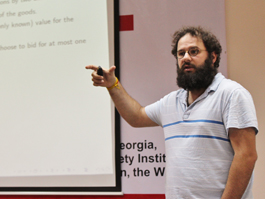On 5 June, Professor Deniz Selman from Bogazici University presented the paper titled “Simultaneous Auctions with Private and Common Values,” which he co-authored with Deniz Nemli. In a simultaneous auction, every bidder submits bids on an item simultaneously. The paper discusses a situation where an item’s value can be of two types, one in which the bidders have private values and another where the value of the item is a publicly known common value.
Prof. Selman started his talk by providing some real life examples of such auctions, for example: contractors bidding for a specialized government contract whose value is complementary to a contractor’s qualities (private value) and another more straightforward government contract (common value);
firms in a labor market bidding for specialized/managerial workers (private value) and unspecialized/clerical workers (common value); and home buyers bidding for a house in which they will live (private value) and a house which they will rent out at market price (common value).
In the paper the authors analyzed two simultaneous sealed-bid auctions in which the number of bidders is n. The seller must choose to participate in just one auction and announce whether his/her good is sold via a first-price or second-price auction. After the auction types are announced, bidders simultaneously decide (1) in which auction to participate and (2) their bid in the selected auction. Bidders thus make their bids without knowing the number of other participants in the same auction. Bidders choose the auctions according to a cut-off strategy: only those with a sufficiently high private value will choose the private auction. In solving for market equilibrium, the authors find that revenue equivalence (according to which a seller’s revenue is the same regardless of whether it is a first - or second-price auction) holds in both auctions when all bidders play the same strategy (symmetric equilibrium), but does not necessarily hold if all bidders do not choose the same strategy (asymmetric equilibrium).
ISET would like to thank Prof. Selman for presenting a very interesting, informative and useful seminar to the ISET community.











